Pera Museum
Thomas Hope (1769–1831), was a merchant banker, author, philosopher and art collector of Dutch and British ancestry. He inherited from his mother a love of the arts, which his family’s enormous wealth made it possible to enjoy. His father spent his final years turning his summer home Groenendaal Park in Heemstede into a sculpture park which he opened to the public. After Thomas fled to London to avoid the French occupation of the Netherlands from 1795–1810, he never returned.
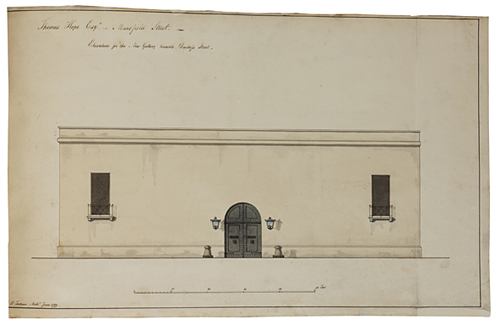
Elevation for the New Gallery towards Duchess Street, 1799
With his two brothers and cousin, Henry, Hope established a residence in London in Duchess Street, Cavendish Square. He decorated the house in a very elaborate style, from drawings made by himself with each room taking on a different style influenced by the countries he had visited. The combined art collections of the family business, Hope & Co., his parents and of Henry Hope gave him the opportunity to further research the various arts that he had studied during his travels and he began to write books on decoration and furniture, the first of its kind. In the same way that he had done with Villa Welgelegen, Henry Hope opened the house as a semi-public museum. The house museum included three vase galleries filled with South Italian vases that the Hopes purchased from Sir William Hamilton’s second vase collection.
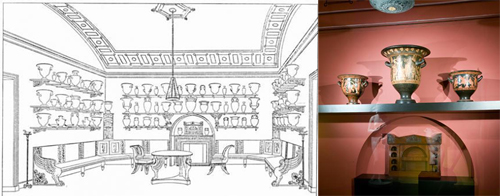
and a recreation by the V&A1
The vases, he wrote, ‘relate chiefly to the Bacchanalian rites connected with the representations of mystic death and regeneration’. He therefore designed shelves and cabinets decorated with carved heads of the bearded Bacchus.
In this eclectic wealthy residence of bachelors, younger brother Henry Philip oversaw the gem collection (acquiring the Hope Diamond and the Hope Pearl), while cousin Henry busied himself with the banking business and the Louisiana Purchase, together with Barings. Thomas Hope did not settle in London, however. He took up his grand tour where he left off, and in 1795 he began his extensive tours of the Ottoman Empire which included visits to Turkey, Rhodes, Egypt, Syria, and Arabia. He stayed for about a year in Istanbul/Constantinople during which he produced some 350 drawings depicting the people and places he witnessed in the Ottoman Empire, a collection now to be found in the Benaki Museum, Athens. During these travels, he was given free rein by the Hope & Co. firm to collect many paintings, sculptures, antique objects and books, some of which were destined to be displayed for the public in Amsterdam and some of which were destined for his London house in Duchess Street in 1804.
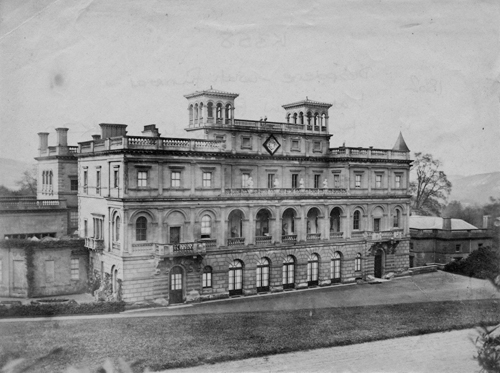
Credit: Dorking Museum
After his marriage to Louisa de la Poer Beresford in 1806, Thomas acquired a country seat at Deepdene, near Dorking in Surrey. The house of 1765-75 had been built for Charles Howard (later the 10th Duke of Norfolk). Here, surrounded by his large collections of paintings, sculpture and antiques, Deepdene became a famous resort of men of letters as well as of people of fashion. Among the luxuries suggested by his fine taste, and provided to his guests, was a miniature library in several languages in each bedroom. He also gave frequent employment to artists, sculptors and craftsmen. Bertel Thorvaldsen, the Danish sculptor, was indebted to him for the early recognition of his talents, and he was also a patron to Francis Leggatt Chantrey and John Flaxman; it was to his order that the latter illustrated the writings of Dante Alighieri.
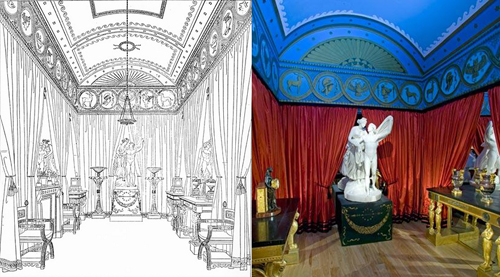
and a recreation by the V&A2
Hope was eager to advance public awareness of historical painting and design and to influence design in the grand houses of Regency London. In pursuit of his scholarly projects, he began sketching furniture, room interiors and costumes, and publishing books with his accompanying scholarly texts.
In 1807 Thomas Hope published sketches of his furniture, in a folio volume, titled Household Furniture and Interior Decoration, which had considerable influence and brought about a change in the upholstery and interior decoration of houses. Hope’s furniture designs were in the pseudo-classical manner generally called ‘English Empire’.
In 1809 Hope published the Costumes of the Ancients, and in 1812 Designs of Modern Costumes, works which display a large amount of antiquarian research. A Historical Essay on Architecture, which featured illustrations based on early Hope drawings, was published posthumously by his family in 1835. Thus Hope became famous in London’s aristocratic circles as ‘the costume and furniture man’. The sobriquet was regarded as a compliment by his enthusiastic supporters, but for his critics, including Lord Byron, it was a term of ridicule.
By the time of his death in 1831 Hope’s contribution to art and architecture had been widely recognised. The dedication to the arts survived and several of the Hope family were members of the Society of Dilettanti. Sadly his physical legacy has almost entirely been lost. The house in Duchess Street was demolished by his son in 1851. His great-grandson and eventual heir, Lord Francis Pelham Hope (8th Duke of Newcastle) ran up enormous debts forcing him to sell the contents of the Deepdene in 1917. From 1918 the main house was first operated as a hotel run by Madame Coletta. By 1920 the estate was divided and sold with much of the parkland developed for residential use. The house became the Southern Railway Company offices in 1939 and was sold by British Railways in 1967 to a development company. It was demolished in 1969 and replaced by an office block. The only complete surviving structure built by Hope was the Hope mausoleum.
Credit: The Guide 2 Surrey
The Hope Mausoleum
In 1814 the Deepdene estate was enlarged when Hope’s brother bought the adjoining estate, Chart Park, for £30,000 and presented it to him. In 1817 tragedy struck when, during a family tour of Italy, Thomas Hope’s youngest son Charles died of a fever in Rome, aged seven. On returning to England the following year, Hope built a family mausoleum on the edge of Chart Park over the burial place of Charles’ ashes. It was probably designed by the architect William Atkinson, who was working on both the Deepdene and Hope’s London house in Duchess Street at this period, but with significant contributions from Hope himself. To date no original architect’s plans or contemporary images have been discovered.
The mausoleum was constructed in the Grecian style, with battered ashlar walls. It has a moulded cornice and a substantial overhanging pediment on the south east or entrance front. Scarring/marking of the pediment would suggest that this once carried a plaque or inscription which has since been removed. There is a central round-headed arched entrance with iron gates with fishscale pattern to the fanlight and double gates with square panels with patterns of intersecting diagonals.
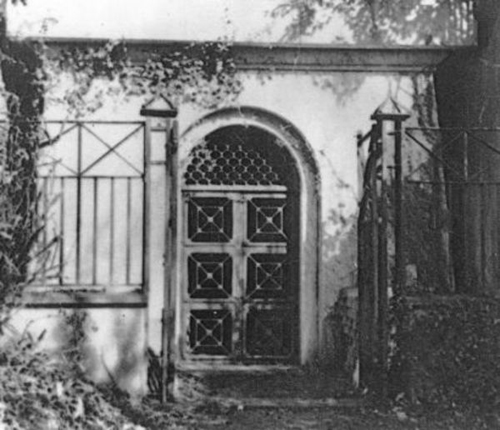
Credit: The Mausolea and Monuments Trust
It was built on a rectangular plan, comprising a rectangular courtyard with projecting side retaining walls leading to the mausoleum which has a rectangular antechamber leading to a larger square burial chamber built into the hillside. An early photograph shows a low courtyard wall with ornamental cast iron railings with pattern of intersecting diagonals to square panels, slender iron gatepiers with pyramidal tops.

(shows fanlight which was examined for paint)
Credit: Alexander Bagnall
The antechamber had oak double doors with brass handles leading to the burial chamber. Thelatter is vaulted in ashlar with giant ribbed round-headed arches. There are 33 loculi (recesses for coffins) arranged in three tiers on three sides, each terminating in two plain cast iron rings.
Thomas Hope died on 2nd February 1831 in London and was buried ten days later in the mausoleum in accordance with his wishes that his body
‘be deposited in the quietest manner next to that of my ever lamented son Charles’.
The estate was inherited by Hope’s eldest son Henry Thomas, who made extensive alterations to the Deepdene, completed around 1840, and enlarged the estate. He was buried in the mausoleum in 1862. The last interment in the mausoleum was of the 8th Duke of Newcastle, buried here in 1941, by which time nine of the loculi were filled by members of the Hope family.
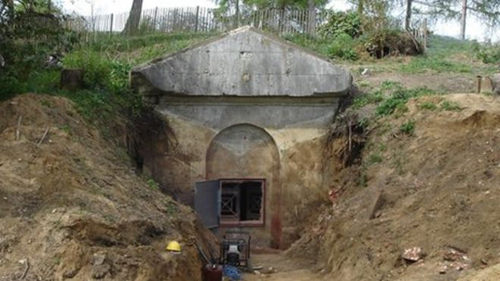
In 1951 the mausoleum was listed Grade II. In 1957, following repeated attempts by vandals to break into the mausoleum the doorway was permanently sealed with bricks and a cement render and the roof of the structure was strengthened with a three inch thick cement render. In 1960 the mausoleum and about one and a half acres of the surrounding land were bequeathed to Dorking Urban District Council (now Mole Valley District Council) by the 9th Duke of Newcastle for the benefit of the public. The proposal was that the council
‘cover over the mausoleum and make the whole area into a garden with garden seats, providing a suitable plaque was erected at the site recording the mausoleum’s existence’.
At some time between 1960 and 1973 the mausoleum was buried but the surroundings were not turned into a garden. In June 2009 part of the top of the south-east front of the mausoleum was uncovered.

Since 2009, the Mausolea and Monuments Trust and Mole Valley District Council have been in negotiation over the conservation and restoration of the mausoleum. In 2013 the council was awarded a £123,000 development grant from the Heritage Lottery Fund aimed at regenerating the historic landscape. A second bid is to follow, which if successful will enable significant work to commence on site in autumn 2014. Initial excavation of the mausoleum was carried out in early 2013 by The Friends of Deepdene with assistance from the Surrey Wildlife Trust, Society of Dilettanti, Kuoni Travel and the Dorking Museum.
I was asked for advice on the colour of the ironwork and undertook an analysis of the inner fanlight

Credit
I am grateful to Alexander Bagnall for his help with this.
My thanks must also go to Dorking Museum, the Mausolea and Monuments Trust, Mole Valley District Council. Much of the above has been taken from Wikipedia.
1These images have been taken from the website of The Costume and Furniture Man.
2These images have been taken from the website of The Costume and Furniture Man.
If you are interesting in donating to the restoration project you can do so here – Just Giving

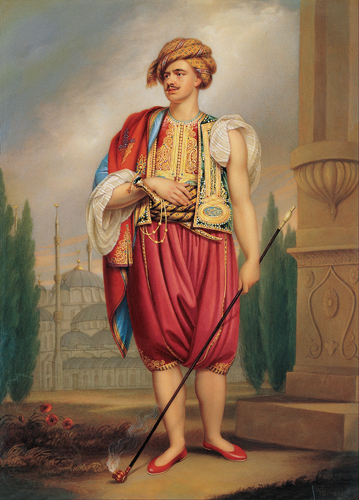
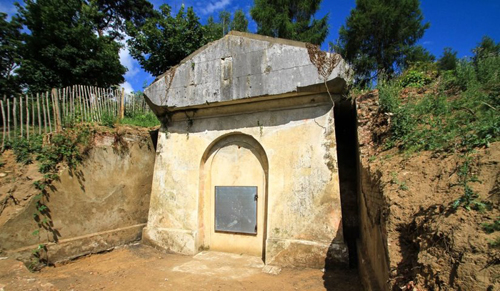










I went to the V&A exhibition on Thomas Hope which I found very interesting. It is a pity that both Duchess St and Deepdene were demolished. The line drawings of the interiors recreated in the exhibition have long interested me.
The drawings have always intrigued me and I thought that the exhibition was fantastic. I leapt at the chance to examine the mausoleum gates as nothing tangible remains of Hope’s use of colour.